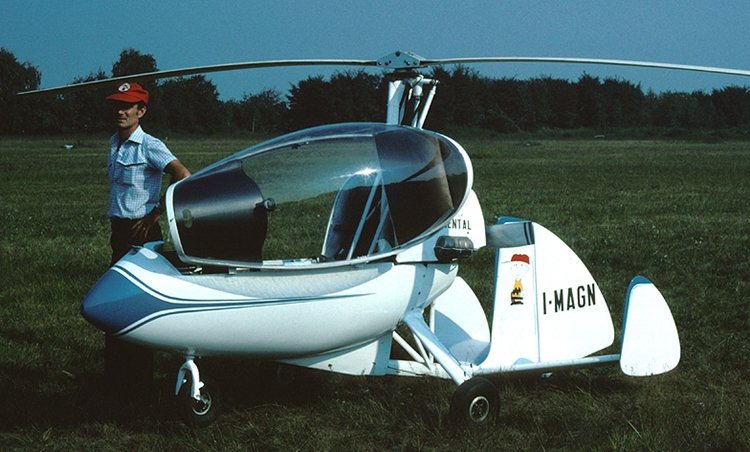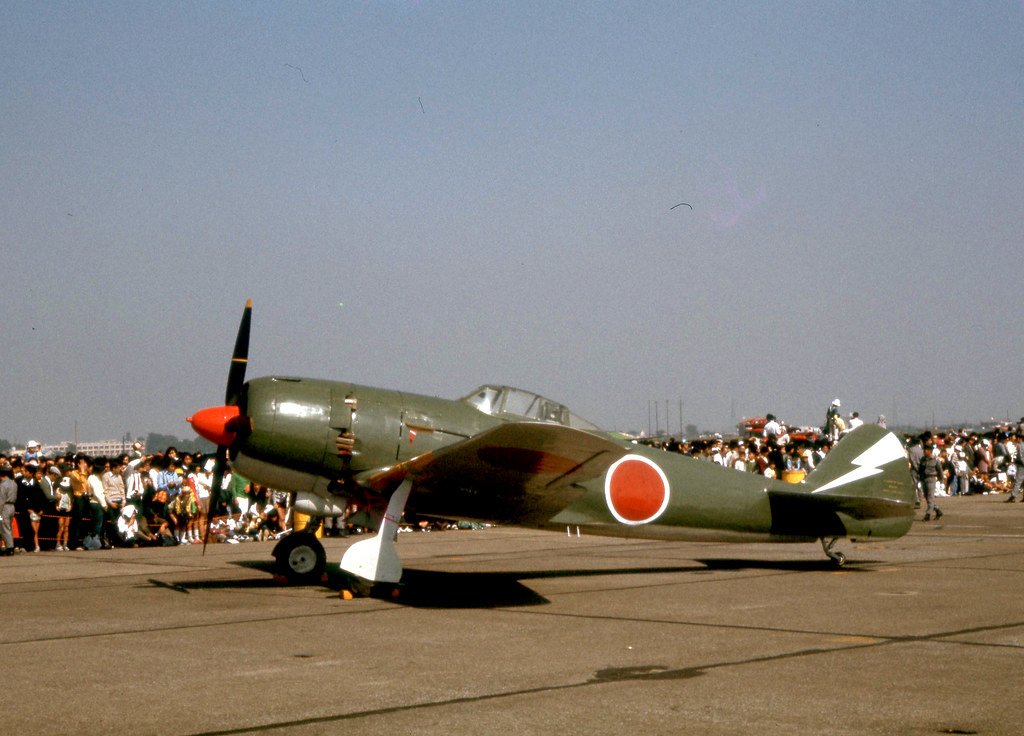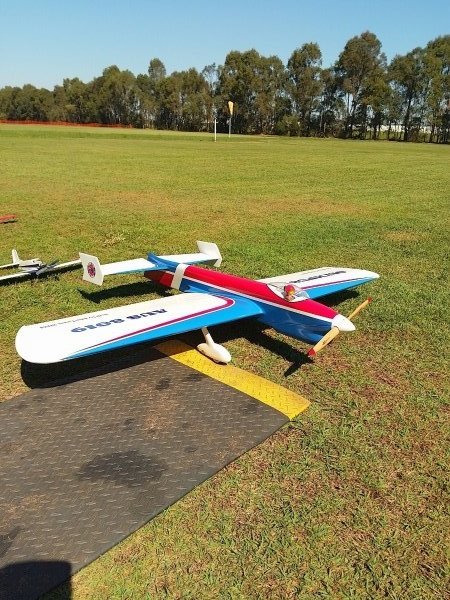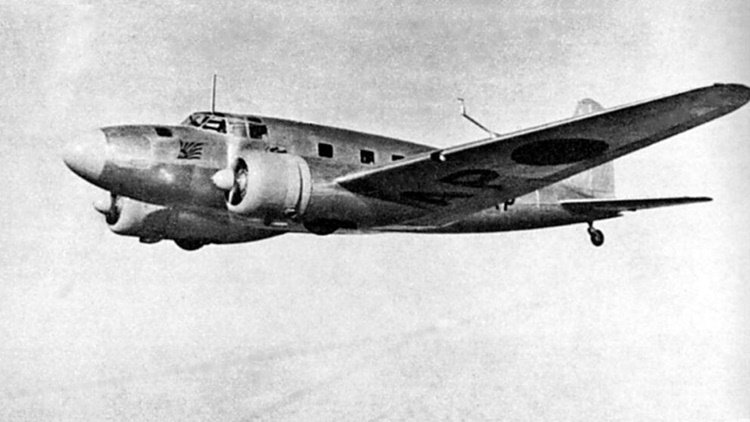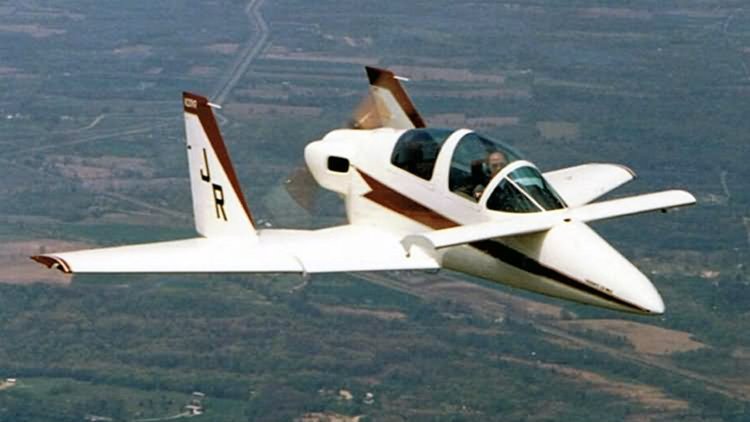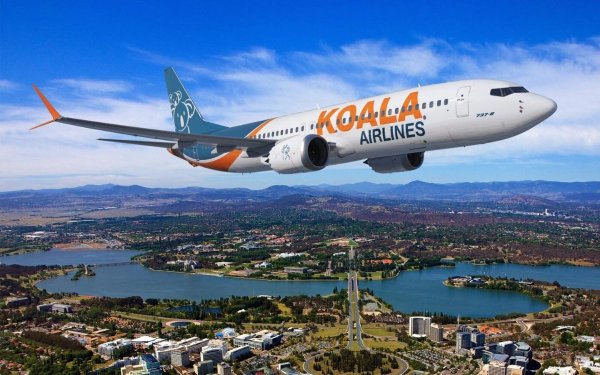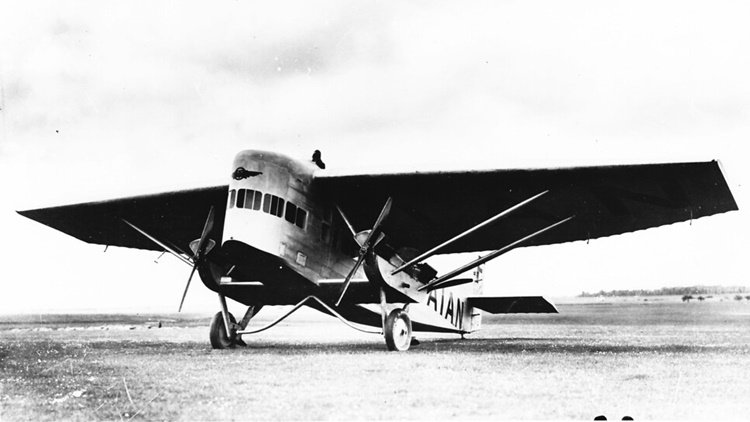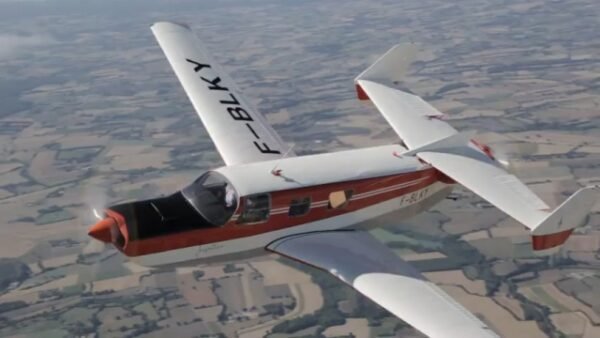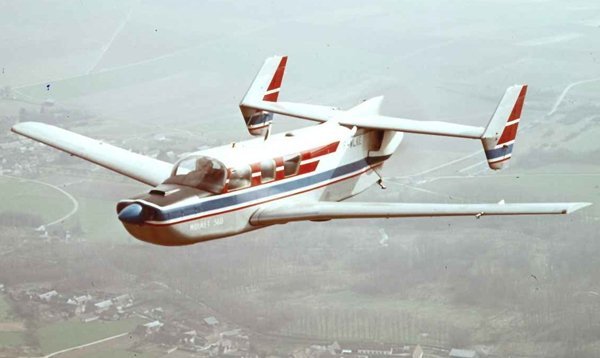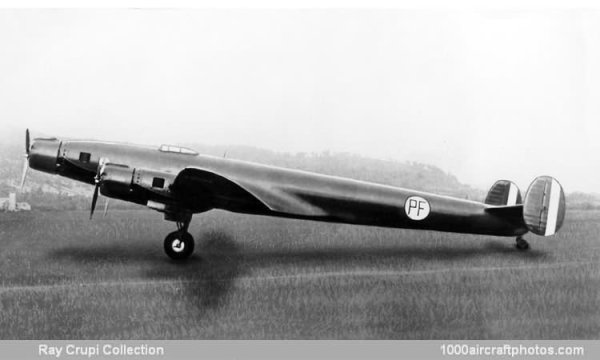-
Posts
7,574 -
Joined
-
Last visited
-
Days Won
67
Content Type
Profiles
Forums
Gallery
Downloads
Blogs
Events
Store
Aircraft
Resources
Tutorials
Articles
Classifieds
Movies
Books
Community Map
Quizzes
Videos Directory
Everything posted by red750
-
The Tervamäki JT-5, later marketed as the VPM MT-5, is a single-seat autogyro developed in Finland by Jukka Tervamäki in the early 1970s and which was marketed in kit form for amateur construction. A development of his ATE-3 design of 1968, the JT-5 first flew in 1973, and Tervamäki sold the prototype, its tooling, and its manufacturing rights the following year. The JT-5 features a streamlined fuselage pod that fully encloses its cockpit and a single, piston engine that drives a pusher propeller. It has a two-bladed main rotor, and fixed, tricycle undercarriage. The structure makes extensive use of composite materials around a frame of welded steel tube. The empennage is a triple tail that consists of a large fin and rudder plus smaller fins at the ends of the horizontal stabiliser, an arrangement that Tervamäki compared to that of the Lockheed Constellation. This configuration was chosen to increase the area of the tail surfaces and therefore the static and dynamic stability of the aircraft. Tervamäki saw this as an important safety feature to reduce the possibility of pilot-induced oscillation, which had been implicated in fatal autogyro crashes. The cockpit is enclosed by an expansive plexiglass canopy that hinges sideways. The instrument panel and the firewall that separates the cockpit from the rotor mast and engine hinge together with the canopy. This feature was intended to facilitate inspection and maintenance of the instruments, nosegear, rudder pedals, and front side of the engine. The level of access to the engine that this created was so great that most routine engine inspection tasks could be carried out without removing the cowling. Provisions for cold weather include an optional cabin heater, a ventilation system to prevent canopy fogging, and a carburettor heater. The prototype was powered by a Volkswagen automotive engine modified for aero use by Limbach Motorenbau. VPM specified a Limbach L1700 for the MT-5 instead. The aircraft is equipped with a pre-rotation mechanism for the rotor. Design work on the JT-5 began in 1969, and construction of the prototype the following year. Initially, the work was shared between Tervamäki and Aulis Eerola, with whom he had collaborated on the ATE-3. Eerola contributed to some of the construction work, but departed the project before its completion. Some of the funding for the development work came from a grant by the Finnish Technical Foundation. Tervamäki estimated that around 2,000 hours' work went into the prototype over three years. He later reflected that this level of effort was contrary to one of the main reasons he had originally been drawn to autogyros: their simplicity. The prototype first flew on 7 January 1973, carrying the registration OH-XYS. Apart from the prototype, at least four other JT-5s were built by 2009, three in Finland and one in Sweden, with a number of others under construction. Tervamäki continued to sell JT-5 plans for some time, with around 60 sets sold by 1979. He later made them available for free download on his personal website.
-
The Nakajima Ki-84 Hayate (キ84 疾風, lit. "Gale") is a single-seat fighter flown by the Imperial Japanese Army Air Service in the last two years of World War II. The Allied reporting name was "Frank"; the Japanese Army designation was Army Type 4 Fighter (四式戦闘機, yon-shiki-sentō-ki). The Ki-84 is generally considered the best Japanese fighter to operate in large numbers during the conflict. The aircraft boasted high speed and excellent maneuverability with an armament (up to two 30 mm and two 20 mm cannon) that gave it formidable firepower. The Ki-84's performance matched that of any single-engine Allied fighter it faced, and its operational ceiling enabled it to intercept high-flying B-29 Superfortress bombers. Pilots and crews in the field learned to take care with the plane's high-maintenance Nakajima Homare engine and landing gear prone to buckling. The difficulties of Japan's situation late in the war took a toll on the aircraft's field performance as manufacturing defects multiplied, good quality fuel proved difficult to procure, and experienced pilots grew scarce. Nevertheless, a well-maintained Ki-84 was Japan's fastest fighter. A total of 3,514 aircraft were built. Design of the Ki-84 commenced in early 1942 to meet an Imperial Japanese Army Air Service requirement for a replacement to Nakajima's own, earlier Ki-43 fighter, then just entering service. The specification recognized the need to combine the maneuverability of the Ki-43 with performance to match the best western fighters, and heavy firepower. The Ki-84 first flew in March 1943[6] and deliveries from Nakajima's Ota factory commenced the following month. Although the design was itself solid, growing difficulties in securing skilled pilots, proper fuel and construction materials, and adequate manufacture often prevented the aircraft from reaching its full potential in the field. The design of the Ki-84 addressed the most common complaints about the popular and highly maneuverable Ki-43: insufficient firepower, poor defensive armor, and lack of climbing speed. The Ki-84 was a cantilever low-wing monoplane of all-metal construction, except for the fabric-covered control surfaces, with conventional landing gear.[8] Armament comprised two fuselage-mounted, synchronized 12.7 mm (.50 in) machine guns — these proved challenging to synchronize properly with the Hayate's four-blade propeller — and two wing-mounted 20 mm cannon, a considerable improvement over the two 12.7 mm (.50 in) machine guns used in the Ki-43 Hayabusa. Defensive armor offered Hayate pilots better protection than the unsealed wing tanks and light-alloy airframe of the Ki-43. In addition, the Ki-84 used a 65 mm (2.56 in) armor-glass canopy, 13 mm (.51 in) of head and back armor, and multiple bulkheads in the fuselage, which protected both the methanol-water tank (used to increase the effectiveness of the supercharger) and the centrally located fuel tank. It was the Nakajima firm's own-designed 35.8-litre (2,180 cu in) displacement, Ha-45 Homare ("Praise" or "Honor") air-cooled eighteen-cylinder radial engine, first accepted for military use in 1941, that gave the Hayate its high speed and prowess in combat. Derived from the Nakajima Homare engines common to many Japanese aircraft, the Hayate used several versions of the Homare engine, including the carbureted model 21 and the fuel-injected model 23 versions of the engine. Most Homare engines used water injection to aid the supercharger in giving the Ki-84 a rated 1,491 kW (2,000 hp) at takeoff. This combination theoretically gave it a climb rate and top speed roughly competitive with the top Allied fighters. Initial Hayate testing at Tachikawa in early summer 1943 saw test pilot Lieutenant Funabashi reach a maximum level airspeed of 624 km/h (387 mph) in the second prototype. In 1946, US Technical Intelligence bench-tested a Homare 45, Model 21 engine and verified the engine's maximum horsepower output using 96 octane AvGas, plus methanol injection. The first major operational involvement was during the battle of Leyte at the end of 1944, and from that moment until the end of the Pacific war the Ki-84 was deployed wherever the action was intense. The 22nd Sentai re-equipped with production Hayates. Though it lacked sufficient high-altitude performance, it performed well at medium and low levels. Seeing action against the USAAF 14th Air Force, it quickly gained a reputation as a combat aircraft to be reckoned with. Fighter-bomber models also entered service. On April 15, 1945, 11 Hayates attacked US airfields on Okinawa, destroying many aircraft on the ground. In the final year of the war the Ki-84, the Ki-100 (essentially a radial-engined version of the inline-powered Kawasaki Ki-61) and Kawanishi's N1K2-J were the three Japanese fighters best suited to combat the newer Allied fighters. For details of the 18 variants, click here. A total of 3,413 units were produced.
-
From Wikipedia, the free encyclopedia The Jurca MJ-5 Sirocco (named for the Sirocco wind) is a two-seat sport aircraft designed in France in the early 1960s and marketed for homebuilding. It is one of many wooden homebuilt designs from Romanian born designer Marcel Jurca. Jurca, a Henschel Hs 129 pilot in World War II marketed the plans in Canada and America through Falconar Aviation. It is a low-wing cantilever monoplane of conventional configuration and wooden construction throughout. The tandem seats are enclosed by a bubble canopy, and the tailwheel undercarriage can be built as either fixed or with retractable main units. Marcel Jurca died on 19 October 2001, at which time plans were still available from the designer's website. Plans are supplied by Avions Marcel Jurca and Manna Aviation of Australia.
-
If you missed tonight's investigation of the Boeing 737 Max fiasco on Channel 7's Spotight program, here is a link to 7plus streaming. https://7plus.com.au/7news-spotlight It is the first link showing Michael Usher, although the investigation was conducted by Liam Bartlett.
-
/graphics/ICAOtype/P28A.gif Runway excursion Incident Piper PA-28-181 Archer II VH-KLU, Thursday 29 August 2024 ASN.FLIGHTSAFETY.ORG A Piper PA-28-181 Archer II veered off the runway when landing at Cessnock Airport (CES/YCNK), Cessnock, New South Wales, and crashed into a fence. The pilot was seriously injured and ta...
-
If not a car, what about a bike? 688K views · 2.6K reactions | Not gonna lie, the prospect of just... WWW.FACEBOOK.COM Not gonna lie, the prospect of just flying over traffic has it's appeal 🙃
-
The Tairov OKO-1 (Opytno Konstrooktorskoye - experimental design section), was a passenger transport aircraft produced in the Ukrainian SSR in the USSR in 1937. Late in 1935 V.K. Tairov helped form the OKO (experimental design section) in Kiev. In 1937 the OKO-1 was completed as a six-seat passenger transport, with all wood construction, this single engined monoplane demonstrated good performance with state-of-the-art systems. Electrically driven flaps, pneumatic wheel brakes, trimmers on all the tail surfaces, heated cabin, lighting and instruments for night or blind flying, full sound-proofing and full GVF(civil air fleet) equipment were all incorporated. The performance of the aircraft in flight tests was regarded as excellent but, for unknown reasons, production was not undertaken. Status cancelled (no production commenced). Number built 1
-
The Mitsubishi Ki-57 was a Japanese passenger transport aircraft, developed from the Ki-21 bomber, during the early 1940s. In 1938, when the Ki-21 heavy bomber began to enter service with the Imperial Japanese Army, its capability attracted the attention of the Imperial Japanese Airways. In consequence, a civil version was developed and this, generally similar to the Ki-21-I and retaining its powerplant of two 708 kW (950 hp) Nakajima Ha-5 KAI radial engines, differed primarily by having the same wings transferred from a mid- to low-wing configuration and the incorporation of a new fuselage to provide accommodation for up to 11 passengers. This transport version appealed also to the navy, and following the flight of a prototype in August 1940 and subsequent testing, the type was ordered into production for both civil and military use. This initial production Ki-57-I had the civil and military designations of MC-20-I and Army Type 100 Transport Model 1, respectively. A total of 100 production Ki-57-Is had been built by early 1942, and small numbers of them were transferred for use by the Japanese navy in a transport role, then becoming redesignated L4M1. After the last of the Ki-57s had been delivered production was switched to an improved Ki-57-II, which introduced more powerful 805 kW (1,080 hp) Mitsubishi Ha-102 14-cylinder radial engines installed in redesigned nacelles and, at the same time, incorporated a number of detail refinements and minor equipment changes. Civil and military designations of this version were the MC-20-II and Army Type 100 Transport Model 2, respectively. Only 406 were built before production ended in January 1945. Both versions were covered by the Allied reporting name "Topsy". Variants Ki-57-I Army Type 100 Transport Model 1: Powered by two 708 kW (950 hp) Nakajima Ha-5 KAI radial engines and a redesigned fuselage to accommodate 11 passengers. About 100 aircraft of this type were built including the civil version. MC-20-I: Same as above but built for civil use with Imperial Japanese Airways (Dai Nippon Koku KK). Ki-57-II Army Type 100 Transport Model 2:Powered by two 805 kW (1,080 hp) Mitsubishi Ha-102 Zuisei 14-cylinder radial engines installed in redesigned nacelles. Minor equipment and detail refinements were also incorporated. 306 aircraft of this type were produced before the end of production in January 1945. Specifications of this model below. MC-20-II: Same as above but built for civil use with Imperial Japanese Airways (Dai Nippon Koku KK). L4M1: A small number of Ki-57-Is were transferred for test by the Japanese navy as transports and were redesignated L4M1.
-
The Rutan VariViggen is a homebuilt aircraft designed by Burt Rutan. The aircraft is a tandem two-seater of primarily wooden construction with a delta wing and a canard foreplane. The VariViggen is powered by a 150 hp Lycoming O-320 aero engine in pusher configuration. The prototype was designated Model 27, and the production version was Model 32. The VariViggen was named after the Swedish fighter plane, the Saab 37 Viggen. This and the XB-70 Valkyrie inspired the design. Rutan became interested in aircraft which resisted stalls and spins, and the VariViggen was his first full scale design. He began working with the design as a student at Cal Poly in the early 1960s, and started building the prototype in his garage in 1968. After four years of work, the aircraft made its first flight in April, 1972. In order to increase efficiency, the Model 32 (also known as the VariViggen SP) had a slightly longer fuselage, a larger wingspan and winglets. The Rutan Aircraft Factory sold 600 plan sets for the VariViggen to homebuilders, and eventually about 20 of the aircraft were built. Following the crash of one in New Brunswick, Canada in September 2006 due to wing tank fuel contamination, fewer than five are currently still flying. The prototype aircraft, N27VV, can be seen in the 1975 movie Death Race 2000 and was eventually donated to the EAA AirVenture Museum in 1988. Currently, (August 2024), there are 63 listed on airport-data.com. Rutan also began work on an all-aluminum variant, the MiniViggen, but later abandoned the project and focused his efforts on the VariEze.
-
Thanks Red, that one had escaped me. Here's the story. The Bristol Type 138 High Altitude Monoplane was a British high-altitude single-engine, low-wing monoplane research aircraft developed and produced by the Bristol Aeroplane Company during the 1930s. It set nine world altitude records, with the maximum altitude achieved being 53,937 ft (16,440 m) on 30 June 1937, during a 2¼-hour flight. A second aircraft, designated as the Type 138B, was ordered in 1935 but work was abandoned during 1937 without it having flown. The Type 138 was built during a period of intense competition between aviation manufacturers. Prestige and useful technological progress came from breaking major aviation records, such as airspeed, distance and altitude but by the 1930s, the resources and development work necessary to achieve these records was beyond individual companies, and required government assistance. Bristol found themselves lagging behind other companies from Germany, Italy, the United States, and the United Kingdom. Between 1929 and 1934, altitude records established by rival aircraft included those set by a Junkers W.34, a Vickers Vespa and a Caproni Ca.113 biplane, as well as the first flight over Everest by a pair of Westland Wallaces in 1933. All of these aircraft had been powered by Bristol engines. Between 1928 and 1938, the altitude record was broken 10 times, once using a Jupiter engine and five times using Pegasus engines which was seen as a major achievement for Bristol's engines. In November 1933, having observed British Air Ministry interest following the success of the Everest flight, aeronautical engineer Frank Barnwell proposed a purpose-built high-altitude research aircraft. This proposal, designated the Type 138, was a large single-engine, single-seat monoplane, equipped with a retractable undercarriage and a supercharged Pegasus radial engine. Nothing came of this until Italian pilot Renato Donati achieved a new world record during April 1934 prompting public opinion to swing in favour of a government-sponsored record attempt. In June 1934, the Air Ministry issued Specification 2/34, for a pair of prototypes capable of reaching an altitude of 50,000 ft (15,240 m). Bristol was among the companies which were invited to tender proposal. Barnwell revised the Type 138 proposal, producing the Type 138A whose size and configuration remained the same, but the retractable undercarriage was replaced with a fixed design to reduce weight and it would be powered by a two-stage supercharged Pegasus engine and provision for an observer was made. Using the Pegasus was expected to generate publicity and boost sales. Considerable research was carried out by both the Royal Aircraft Establishment (RAE) and National Physical Laboratory to fine tune the design of the aircraft, as well as to develop a reliable pressure suit to be worn by the pilot. Sir Robert Davis of Siebe Gorman and Professor J.S. Haldane were instrumental in developing the helmet. During tests, the pressure suit was tested to the equivalent altitude of 80,000 ft (24,384 m). In early 1936, the airframe was completed and on 11 May 1936 the Type 138A was flown for the first time by Cyril Uwins, Bristol's chief test pilot, who had previously flown the Vickers Vespa on its world record flight. As the engine was not ready, it was powered by a standard Pegasus IV driving a three-bladed propeller for the early flights. Two additional flights were performed at Filton prior to the aircraft being delivered to the RAE at Farnborough where the pressure helmet was tested prior to the aircraft being returned to Filton for the installation of the special Pegasus engine and a four-blade propeller. On 5 September 1936, the Type 138A returned to Farnborough for more test flights. For details of design. operational history, variants and specificatiions, click here.
-
The Boeing Model 200 Monomail was an American mail plane of the early 1930s. The aircraft marked a departure from the traditional biplane configuration for a transport aircraft, instead featuring a single, low set, all metal cantilever wing. Retractable landing gear and a streamlined fuselage added to the aerodynamic efficiency of the aircraft. A single example was constructed for evaluation by both Boeing and the US Army (under the designation Y1C-18) but no mass production ensued, and the aircraft eventually joined Boeing's fleet on the San Francisco-Chicago air mail route from July 1931. A second version was developed as the Model 221, with a fuselage stretched by 8 inches (20 cm) that sacrificed some of its cargo capacity to carry six passengers in an enclosed cabin; the single pilot, however, sat in an open cockpit. This version first flew on 18 August 1930. Both the Model 200 and the Model 221 were eventually modified for transcontinental service as the Model 221A, with slight fuselage stretches to give both a cabin for eight passengers. These aircraft were flown on United Air Lines' Cheyenne-Chicago route. The advanced design of the Monomail was hampered by the lack of suitable engine and propeller technology. By the time variable-pitch propellers and more powerful engines were available, the design had been surpassed by multi-engined aircraft, including Boeing's own 247. However, many advancements of the Monomail were incorporated into the designs of the most advanced bomber and fighter aircraft of the early 1930s, the Boeing B-9 and the Model 248 (later developed into the P-26 Peashooter of the USAAC), respectively. Variants Model 200 mailplane (1 built) Model 221 mailplane with capacity for 6 passengers (1 built) Model 221A Model 200 and 221 converted as 8-passenger airliners Model 231 Planned lengthened version of Model 221, not built.
-
We know that, but they are regularly called that to scare the tourists.
-
From Spotter Magazine: Australia never seems to run out of brave entrepreneurs trying their luck in the domestic air travel market. With the demise of Bonza and Rex, enter Koala Airlines. Although few details are known about the Melbourne-based carrier, the proposed airline already has a website up and running, a full management team in place, and the all-important Air Operators Certificate. Koala Airlines is hoping to commence Boeing 737 MAX 8 operations shortly.
-
The Caproni Vizzola C22 Ventura was a light jet-powered aircraft developed in Italy for use as a military trainer. It was of conventional sailplane configuration and bore a family resemblance to the Caproni Calif gliders, although the Ventura had an almost entirely metal structure. The student and instructor sat side by side under an expansive canopy, and weapons hardpoints were provided under each of the slender, high-mounted wings. It had retractable, tricycle undercarriage. In 1981, Agusta acquired 50% of the C22 programme and proposed a new version, the C22R, which was to have been a reconnaissance aircraft also capable of Forward Air Control and ELINT operations. The basic C22J trainer was exhibited at the Farnborough Air Show in 1980 and September 1982, but failed to attract any customers, and the proposed C22R was never actually built.
-
The Farman F.120 were a family of multi-engine monoplane aircraft designed and produced by the French aircraft manufacturer Farman Aviation Works. It was operated in a diverse range of purposes, including as a commercial airliner and as a military bomber aircraft. The F.120, which received the nickname of Jabiru after a Latin American stork, was a fixed-undercarriage monoplane powered by either two, three or four engines, depending on the variant. It featured an unusually broad chord, low aspect-ratio main wing and a relatively deep fuselage. The trimotor variant had the centerline engine mounted high, which gave the aircraft an unusual appearance. During the early 1920s, the Aero Club of France set out numerous rules and regulations for its commercial airplane contest of 1923. Shortly following their issuing, Farman set about the designing of a new commercial aircraft that would, so far as reasonably possible, entirely fulfil these regulations; they had been judged to be of importance of the prospective aircraft's market appeal as various aerial-navigation companies had, formally or otherwise, adopted these regulations as requirements for their own needs. Additionally, the company's design team pursued several other ambitions, including high reliability levels, good onboard comfort levels, favourable flying characteristics, while also being as economically efficient as possible. The F.121 or F.3X was the first version to fly, with four 180 hp Hispano-Suiza 8Ac V8 engines mounted in tandem push-pull pairs mounted on stub wings, however, this arrangement caused cooling problems for the rear engines and the F.120/F.4X version followed shortly afterwards, powered by three 300 hp Salmson Az.9 radial engines. Development continued and a single F.122, modified from an F.4X, was powered by a pair of 400 hp Lorraine 12Db engines. Two military versions were also built, the F.123 with two 450 hp Hispano-Suiza 12Hb V12s, or F.124 with two 420 hp Gnome et Rhône 9Ad Jupiter radial engines. The Farman F.120 was a multi-engine multirole monoplane aircraft. It was relatively well-furnished for the era, being able to routinely conduct night flights via equipment such as searchlights, landing flares, position lights, and general illumination. Various passenger conveniences were present, including individual electric heaters and relatively large glass windows for the passengers to view the landscape below. The electricity, used by the radio set, illumination, and heating, was supplied from wind-driven generators using compact propellers that could be drawn inside the fuselage when not in use. In comparison to most contemporary aircraft, the aircraft possessed greater manoeuvrability, possessed relatively high stability, ease of handling, and was relatively easy to land. Dependent on the variant of the aircraft, as many as four engines could be installed. No significant structural changes were required for those aircraft equipped with a different number of engines, such as the trimotor and twin-engined variants. Mid-flight access to the engine was provided via special doors, permitting inspection and even minor repairs to be performed by the crew. The four-engined model of the aircraft had sufficient power that it could still consistently climb even with a single engine out; even the twin-engined model could maintain stable flight on only a single operational engine. The main fuel tanks were housed within the wing, relatively far from the engines; up to two auxiliary fuel tanks could be installed within the engine nacelles, and would operate independently of the main tanks. The aircraft possessed relatively high fuel efficiency for the era. The F.120 was equipped with a relatively thick wing, possessing a span of 19 m (62.34 ft.) and a chord of 6 m (19.68 ft.) at its centre. Both the thickness and the chord of the wing decrease towards the tips. The supporting framework of the wing was entirely enclosed. Both the spars and struts formed V-shaped girders on either side of the fuselage. The undercarriage consists of two main wheels that were supported by a pair of vertical V-shaped members that joined with oblique steel tubing to connective with the base of the fuselage. The fuselage was internally divided into various sections; the foremost section contained the baggage compartment along with, after which and just forward of the wing, the cockpit. This cockpit provided two seats for its crew, typically comprising one pilot and an assistant. The centre of the fuselage was occupied by the passenger compartment, which had sufficient space for up to 12 passengers to travel on comfortabl e seats even with a central aisle. To the rear of the fuselage was the navigator's room, which was fairly sizable and provisioned with then-modern instrumentation, including a drift meter, compass, radio set, work table and map holder; adjacent to this room was the lavatory. Primary access to the interior was via a single sliding door, while multiple exits were provided across the aircraft to aid in emergency egress. On account of having an entirely unobstructed fuselage base, it was relatively straightforward to convert the aircraft into an armed military configuration, such as that of a bomber or a torpedo plane. Furthermore, its speed and manoeuvrability were sufficient that it could realistically engage in aerial combat despite its carriage of relatively heavy bomb loadouts. The presence of multiple independent engines and its reliability meant that the aircraft could be realistically used over the sea. Despite being most commonly seen in lists of ugliest aircraft, following its first flight in 1923, the F.120 won a French airliner competition, the 1923 Grand Prix des Avions de Transports and its 500,000 francs first prize, before seeing service with several European airlines. The F.120 was capable of carrying up to nine passengers, and served on Farman airline's route Paris-Brussels-Amsterdam, but also with Danish Air Lines between Copenhagen and Amsterdam. They served until the late 1920s. Variants F.120 A single engined biplane bomber, powered by a 280 kW (370 hp) Lorraine 12Da engine. First flown in 1924, only two F.120 bombers were built. F.4X The original designation of the F.120 Jabiru F.120 Jabiru Four transport monoplanes powered by 3x 220 kW (300 hp) Salmson 9AZ water-cooled radial engines. F.3bis A twin engined transport aircraft powered by 2x 300 kW (400 hp) Lorraine 12Db engines, 1 built. F.3X The original designation of the F.121 Jabiru prototype. F.121 Jabiru (Specifications below) Nine transport aircraft powered by 4x 130 kW (180 hp) Hispano-Suiza 8Ac engines, one also modified from a F.120 Jabiru. F.122 A single transport aircraft powered by 2x 300 kW (400 hp) Lorraine 12Db engines. F.123 A single three-seater bomber powered by 2x 300 kW (400 hp) Hispano-Suiza 12Hb engines. F.124 A single three-seater bomber powered by 2x 310 kW (420 hp) Gnome et Rhône 9Ad Jupiter engines. Farman 121 Jabiru (4 engine) Farman 120 Jabiru (3 engine) Farman 123 Bomber (2 engine)
-

a couple of left over b17s after the war.
red750 replied to BrendAn's topic in Aircraft General Discussion
This is a direct link to the aircraft graveyards page: https://planehistoria.com/the-silent-witness-of-air-history-aircraft-graveyards/ -
C5 USAF.mp4 MP4 file sent to me by email. No URL so I couldn't post in Media.
-
- 2
-

-
The Moynet M 360 Jupiter was a small executive transport built in France in the 1960s. It had an unusual twin-push-pull, single-fuselage configuration. Two prototypes were produced, the second with more power and seating, but no sales resulted. Some civil propeller driven aircraft that have used one or more pairs of engines in push-pull configuration have been flying boats, with engines mounted above the wing and clear of spray. Others have had a pair of engines, one at either end of a pod fuselage with a tail unit mounted on a pair of booms, for example the Cessna Skymaster, the Adam A500 or the Rutan Voyager. The Moynet 360 Jupiter was an example of a push-pull aircraft of a less common configuration, where a single conventional fuselage has an engine at either end; the Dornier Do 335 fighter used the same arrangement. For light civil aircraft, the aim was to combine the performance of a conventional twin-engined aircraft with the ease of handling of a single-engined one. The Jupiter was an executive transport with between four and seven seats, depending on engine power. It was designed by André Moynet, a member of the National Assembly of France and a former government minister, while also a test-pilot, and built by S.S. Engins Matra (so it is sometimes referred to as the Matra Moynet Jupiter), the first prototype flying on 17 December 1963 with the designer and Lucien Tieles at the controls. Its wing had a straight trailing edge, but the centre section had strong taper on the leading edge which continued more weakly outboard. It was of two spar, stressed skin construction, carrying mass balanced ailerons and slotted flaps. The main undercarriage legs, placed at the end of the centre section each carried a single wheel and retracted inwards electrically. A retractable nosewheel completed the landing gear. One horizontally opposed Lycoming engine was conventionally placed in the nose. Behind it was a standard cabin, though the front seats were further ahead of the leading edge than usual because of the rearward shift of the centre of gravity caused by the rear engine. There were three large windows on each side. For the same reason the rear fuselage was quite short, and it lacked the normal taper, giving it a boxy look, so that the second, pusher Lycoming could be mounted in the extreme tail. This was cooled by air from rectangular intakes on the upper sides of the rear fuselage. The straight edged, tapered tailplane was mounted on the fuselage top above the engine, with small endplate fins carrying balanced rudders. These fins extended above and below the tailplane, with arrow shaped leading edges and straight, swept trailing edges. There was also a long, shallow strake over the rear fuselage. Seen from below, the long span of the tailplane was striking, about 44% of that of the wings; the elevators filled most of the outer part of its trailing edge, avoiding the propeller airstream. Only two Jupiters were built. The first, designated 360-4 and initially registered as F-WLKE had two 200 hp (150 kW) Lycoming IO-360-A1A engines driving two-bladed propellers and was configured as a 4-5 seater.
-
The Piaggio P.23R, also known as the Piaggio P.123 for propaganda purposes, was an Italian commercial transport aircraft prototype designed and built by Piaggio. Unrelated to Piaggio P.23M. Piaggio designed the P.23R specifically to break speed records for commercial transport aircraft. It was a three-engine low-wing cantilever monoplane with twin tail fins and rudders. The three 671-kilowatt (900-horsepower) Isotta Fraschini Asso ("Ace") XI R V-12 engines were mounted in aerodynamically clean, sleek cowlings and each drove a three-bladed propeller. The fuselage was pencil-shaped. The crew of two sat side by side in separate open cockpits, each protected by a windscreen. The P.23R later was re-engined with three 746-kilowatt (1,001-horsepower) Piaggio P.XI RC.40 radial engines and its landing gear was modified. In addition, both cockpits were enclosed with canopies.
-
The Piaggio P.23M was an Italian commercial transport aircraft prototype designed and built by Piaggio. Piaggio designed the P.23M specifically for flights across the North Atlantic Ocean, intending it to have potential for development as a commercial transport. It was a four-engine shoulder-wing monoplane with inverted gull wings and twin tail fins and rudders. To allow an easier landing if the aircraft had to ditch at sea, its fuselage was designed like a boat hull, which Piaggio termed an avion marin ("marine aviation") design, although the aircraft was not a flying boat. The main landing gear was retractable. The P.23M's four 671 kW (900 hp) Isotta-Fraschini Asso XI R. V-12 engines were mounted on the wings in two tandem pairs, each engine driving a two-bladed propeller; two of the propellers were mounted as pushers and the other two in a tractor configuration. Only one built.
-
The Piaggio P.16 was an Italian heavy bomber designed and built by Piaggio for the Regia Aeronautica (Italian Royal Air Force). The P.16 was a three-engine shoulder-wing monoplane of mostly metal construction, with inverted gull wings. Its wing was thick and semi-elliptical, and its tail was mounted high on the fuselage. It had retractable main landing gear and a spatted, non-retractable tailwheel. In addition to bombs, its armament consisted of four 7.62-millimeter (0.3-inch) machine guns, of which two were mounted in the leading edge of the wing, one in a retractable dorsal turret, and one in the rear of the fuselage beneath the tail. The bombardier (bomb-aimer) manned a compartment set behind the nose engine on the underside of the fuselage. The P.16 first flew in November 1934, and an order for 12 aircraft was placed and then cancelled, with preference given to the Piaggio P.32, which was produced from 1936 to 1939.
-

Piper Archer down SW Sydney 22/08/2024
red750 replied to planedriver's topic in Aircraft Incidents and Accidents
Archers have fixed gear. It's the Arrow with retractables. -
The Victa Aircruiser was a 1960s Australian four-seat touring monoplane designed by Henry Millicer and built by Victa. It was not put into production by Victa, and the rights were sold to AESL in 1969. Following the success of the earlier Airtourer, Millicer designed a four-seat version which he called the Aircruiser. The prototype registered VH-MVR first flew on 18 July 1966. Like the Airtourer it was a low-wing monoplane with a fixed nosewheel landing gear and powered by a 210 hp (157 kW) Continental IO-360-H piston engine. Rather than the sliding clear Perspex canopy of the Airtourer, the four-seat Aircruiser had a fixed cabin roof with a single "car type" door on the left hand side. Although Victa completed certification testing, no production of the Aircruiser followed, as Victa closed down its Aviation Division after failing to get financial assistance from the Australian government. Both Victa and Transavia Corporation had requested subsidies for Australian-designed and -built light aircraft, with Victa seeking a subsidy of up to 60% of the factory cost. Following the sale of the design rights of the Airtourer to Aero Engine Services Limited (AESL) of New Zealand, the rights to the Aircruiser were also sold to AESL in 1969. AESL's Chief Designer Pat Monk re-designed the aircraft as the AESL CT/4 Airtrainer, a fully aerobatic (+6G, -3G) military trainer. In 2013 Brumby Aircraft Australia announced the company had purchased the type certificate for the Victa Aircruiser to be developed into the Brumby Aircruiser.
-
The Grumman F2F was a single-engine, biplane fighter aircraft with retractable undercarriage, serving as the standard fighter for the United States Navy between 1936 and 1940. It was designed for both carrier- and land-based operations. Grumman's success with the two-seat FF-1, which was significantly faster than even the single-seat fighters of its time, resulted in a contract for the single-seat XF2F-1. Armed with two 0.30 in (7.62 mm) machine guns above the cowl, the new design also incorporated watertight compartments to reduce weight and improve survivability in the event of a water landing. The prototype first flew on 18 October 1933, equipped with the experimental 625 hp (466 kW) XR-1534-44 Twin Wasp Junior radial engine, and reached a top speed of 229 mph (369 km/h) at 8,400 ft (2,600 m) – 22 mph (35 km/h) faster than the FF-1 at the same altitude. Maneuverability also proved superior to the earlier two-seat aircraft. The Navy ordered 54 F2F-1 fighters on 17 May 1934, with the first aircraft delivered 19 January 1935.[citation needed] One additional aircraft (BuNo 9997) was ordered to replace one which crashed on 16 March 1935, bringing the total to 55, with the final F2F-1 delivered on 2 August 1935.[citation needed] The F2F-1 had a relatively long service life for the time, serving in front-line squadrons from 1935 to late 1939, when squadrons began to receive the F3F-3 as a replacement. By September 1940, the F2F had been completely replaced in fighter squadrons and was relegated to training and utility duties. The last F2F-1s were stricken from the list of naval aircraft in early 1943. Variants XF2F-1 United States Navy designation for the Grumman Model G-8 prototype with a 625 hp (466 kW) XR-1534-44 Twin Wasp Junior radial engine, one built F2F-1 Production variant with a 700 hp (522 kW) R-1535-72 Twin Wasp Junior radial engine, 55 built.


